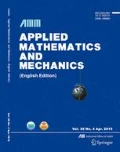Abstract
Based on the concept of the constitutive relation error along with the residuals of both the origin and the dual problems, a goal-oriented error estimation method with extended degrees of freedom is developed. It leads to the high quality local error bounds in the problem of the direct-solution steady-state dynamic analysis with a frequency-domain finite element, which involves the enrichments with plural variable basis functions. The solution of the steady-state dynamic procedure calculates the harmonic response directly in terms of the physical degrees of freedom in the model, which uses the mass, damping, and stiffness matrices of the system. A three-dimensional finite element example is carried out to illustrate the computational procedures.
Similar content being viewed by others
References
Zhang, R., Zhang, C., and Jiang, J. A new approach to direct solution of 2D heat transfer problem with nonlinear source-terms in frequency domain. International Journal of Nonlinear Sciences and Numerical Simulation, 7(3), 295–298 (2006)
Ainsworth, M. and Tinsley-Oden, J. A Posteriori Error Estimation in Finite Element Analysis, Wiley-InterScience, New York, 1–240 (2000)
Tinsley-Oden, J. and Prudhomme, S. Estimation of modeling error in computational mechanics. Journal of Computational Physics, 182, 496–515 (2002)
Tinsley-Oden, J., Prudhomme, S., and Bauman, P. On the extension of goal-oriented error estimation and hierarchical modeling to discrete lattice models. Comput. Methods Appl. Mech. Engrg., 194, 3668–3688 (2005)
Fuentes, D., Littlefield, D., Tinsley-Oden, J., and Prudhomme, S. Extensions of goal-oriented error estimation methods to simulations of highly-nonlinear response of shock-loaded elastomerreinforced structures. Comput. Methods Appl. Mech. Engrg., 195, 4659–4680 (2006)
Prudhomme, S. and Tinsley-Oden, J. On goal-oriented error estimation for elliptic problems: application to the control of pointwise errors. Comput. Methods Appl. Mech. Engrg., 176, 313–331 (1999)
Tinsley-Oden, J. and Prudhomme, S. Goal-oriented error estimation and adaptivity for the finite element method. Computers and Mathematics with Applications, 41, 735–756 (2001)
Ladeveze, P., Rougeota, P., Blanchardb, P., and Moreaub, J. P. Local error estimators for finite element linear analysis. Comput. Methods Appl. Mech. Engrg., 176, 231–246 (1999)
Chamoina, L. and Ladevèze, P. Strict and practical bounds through a non-intrusive and goaloriented error estimation method for linear viscoelasticity problems. Finite Elements in Analysis and Design, 45, 251–262 (2009)
Panetier, J., Ladeveze, P., and Chamoin, L. Strict and effective bounds in goal-oriented error estimation applied to fracture mechanics problems solved with XFEM. Int. J. Numer. Meth. Engng., 81, 671–700 (2010)
Gratsch, T. and Bathe, K. J. A posteriori error estimation techniques in practical finite element analysis. Computers and Structures, 83, 235–265 (2005)
Schleupen, A. and Ramm, E. Local and global error estimations in linear structural dynamics. Computers and Structures, 76, 741–756 (2000)
Larsson, F., Hansbo, P., and Runesson, K. Strategies for computing goal-oriented a posteriori error measures in non-linear elasticity. Int. J. Numer. Meth. Engng., 55, 879–894 (2002)
Van der Zee, K. G. and Verhoosel, C. V. Isogeometric analysis-based goal-oriented error estimation for free-boundary problems. Finite Elements in Analysis and Design, 47, 600–609 (2011)
Van der Zee, K. G., Tinsley-Oden, J., Prudhomme, S., and Hawkins-Daarud, A. Goal-oriented error estimation for Cahn-Hilliard models of binary phase transition. Numerical Methods for Partial Differential Equations, 27(1), 160–196 (2011)
Ni, Y. Q., Zheng, G., and Ko, J. M. Nonlinear periodically forced vibration of stay cables. Journal of Vibration and Acoustics, 126(2), 245–252 (2004)
Challamel, N. On the comparison of Timoshenko and shear models in beam dynamics. Journal of Engineering Mechanics-ASCE, 132(10), 1141–1146 (2006)
Han, S. M., Benaoya, H., and Wei, T. Dynamics of transversely vibration beams using four engineering theories. Journal of Sound and Vibration, 225(5), 935–988 (1999)
Author information
Authors and Affiliations
Corresponding author
Additional information
Project supported by the National Natural Science Foundation of China (No. 10876100)
Rights and permissions
About this article
Cite this article
Lin, Zj., You, Xc. & Zhuang, Z. Goal-oriented error estimation applied to direct solution of steady-state analysis with frequency-domain finite element method. Appl. Math. Mech.-Engl. Ed. 33, 539–552 (2012). https://doi.org/10.1007/s10483-012-1569-x
Received:
Revised:
Published:
Issue Date:
DOI: https://doi.org/10.1007/s10483-012-1569-x
Key words
- goal-oriented error estimation
- finite element method (FEM)
- direct-solution steady-state analysis
- frequency domain




